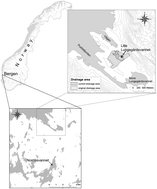Urban contamination sources reflected in inorganic pollution in urban lake deposits, Bergen, Norway
Abstract
The 7000 years transition from a pristine environment towards a modern city has brought a number of chemical changes and effects to urban lake sediments in Bergen. Metals, such as Pb, Hg, Zn, Cu and Fe, display a large anthropogenic influence and reflect historical point sources that existed within the drainage area from approximately AD 1790 until today. The concentration peaks alternate with intervals of lower concentration due to phases of coarser grained sediment input but also periods of potentially reduced metal influx. All discussed elements, except Cd, increase in concentration with decreasing grain size and also correlate with the amount of clay fraction particles. The results emphasize the importance of considering grain size when interpreting sediment chemistry. Correlation with TOC is not apparent in the same extent. The transition from natural to anthropogenically influenced sediments, which is characterised by a sudden increase of several elements, is accompanied by a reduction in Cd, As and Ni concentration. This is interpreted to be the result of hypoxia, changes in pH and reduced erosional input. Factor analysis and the comparison with reference sediments indicate that the elements Pb, Hg, Zn and Cu most clearly demonstrate man-made pollution. Analyses of stormwater culvert sediments suggest that urban runoff contributes to the pollution load today, with standing building mass and traffic contributing to the load.


 Please wait while we load your content...
Please wait while we load your content...